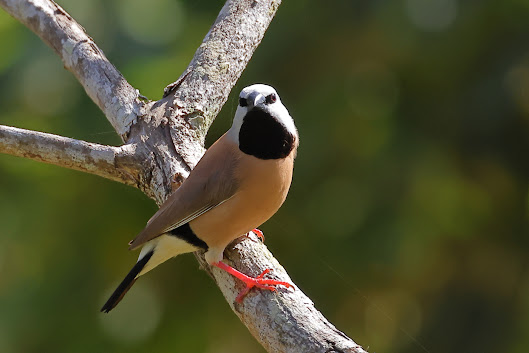
Some days start well and just keep getting better. Hard to top today's start of Chestnut-breasted Mannikins (Lonchura castaneothorax) sprucing up in one of the new pools near Tyto's entrance. So, two pix for them.


Onwards, to one of many Brown-backed Honeyeaters (Ramsayornis modestus) busy, busy, busy gathering nesting material. (Yellows, and Browns doing likewise).

Nearby, male Rufous Whistler (Pachycephala rufiventris) sang and danced methodically through the cheesewoods in typical togetherness with mate (which didn't pose for me).

Plaintive noises from amid the mistletoe led to juvenile Red-winged (Aprosmictus erythropterus) whingeing at parent, which seemed immune to pleas, suggesting the youngster knuckle down and find its own fare by following mother's example. Later, similar story with male (below) and another juvenile.


Still better to come. Splash and dash from pool announced presence of Little Kingfisher (Ceyx pusilla). Bit of chasing about led to another pool and bird sitting pretty high off water. (Have helped several birdos find the reclusive Littles lately.)

No trouble finding Forest Kingfisher (Todiramphus macleayii). But few of them are willing to sit around when people come by. Picture one of several taken with new 2x converter, which means losing Auto Focus and many, many botched shots!)

No need for 2x when White-browed Robin (Poecilodryas superciliosa) turns up close to the Little Kingfisher pool. Bird jaunted about in the shadows briefly and just as quickly flashed off deeper into the trees.

Last bird of the morn, Rufous-thoated Honeyeater (Conopophila rufogularis) head down and hard at it to gather soft lining for nest in nearby paperbark. (Brown-backed and Rufous specialise in big bulky ovals with verandahed side entrances.)

To round off the outing, a Common Tree Snake sunning as I entered the hide, re-emerged from hiding, tasted the air, decided there was no threat and came from three metres away and almost over my outstretched hand before heading out and up off the bench and into a paperbark.
As I said, the morning just kept getting better!
(Note: used Picasa tools to fast-process all this post. One nit: can't scale images, so some inconsistent sizing.)


















































